DODGE NEON 1999 Service Repair Manual
Manufacturer: DODGE, Model Year: 1999, Model line: NEON, Model: DODGE NEON 1999Pages: 1200, PDF Size: 35.29 MB
Page 1081 of 1200
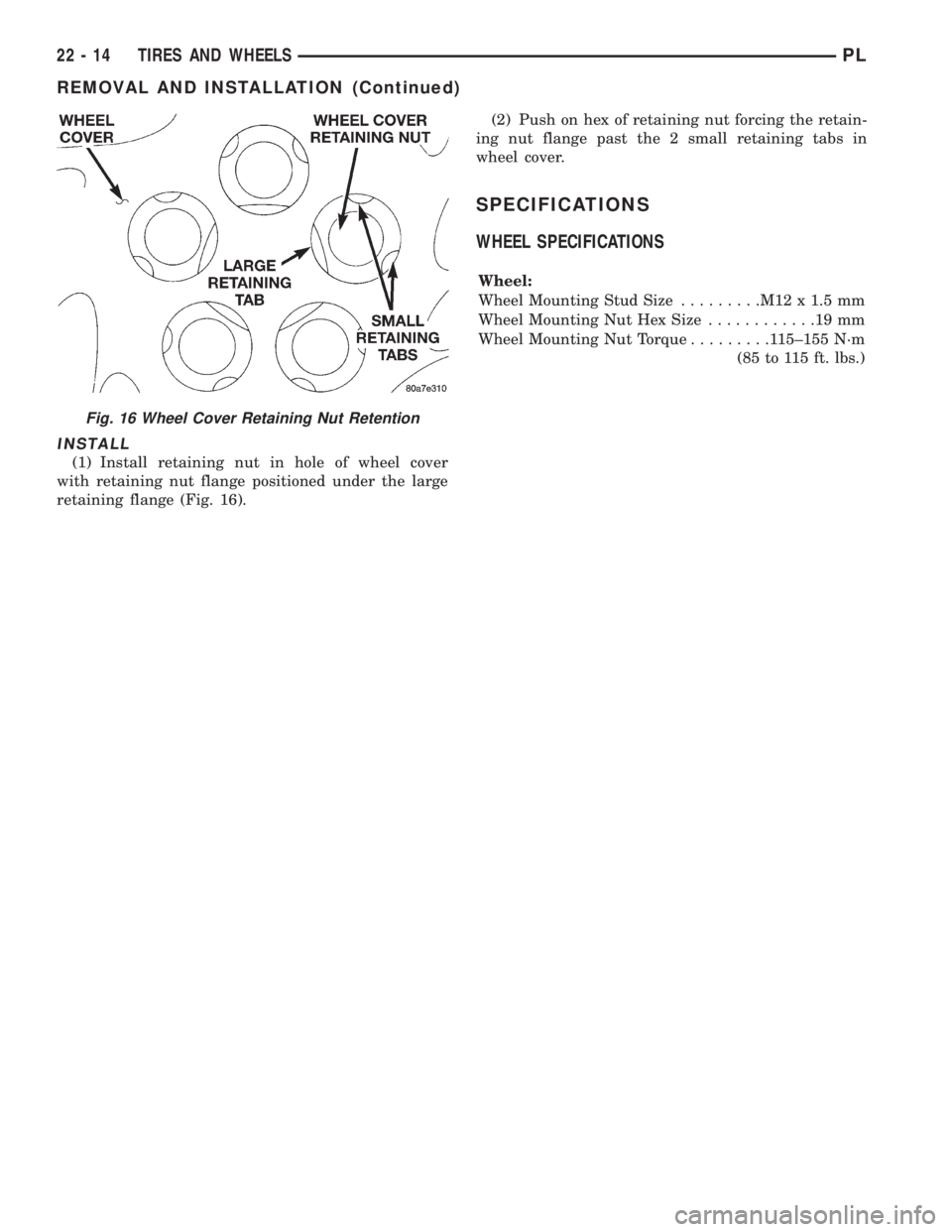
INSTALL
(1) Install retaining nut in hole of wheel cover
with retaining nut flange positioned under the large
retaining flange (Fig. 16).(2) Push on hex of retaining nut forcing the retain-
ing nut flange past the 2 small retaining tabs in
wheel cover.
SPECIFICATIONS
WHEEL SPECIFICATIONS
Wheel:
Wheel Mounting Stud Size.........M12 x 1.5 mm
Wheel Mounting Nut Hex Size............19mm
Wheel Mounting Nut Torque.........115±155 N´m
(85 to 115 ft. lbs.)
Fig. 16 Wheel Cover Retaining Nut Retention
22 - 14 TIRES AND WHEELSPL
REMOVAL AND INSTALLATION (Continued)
Page 1082 of 1200
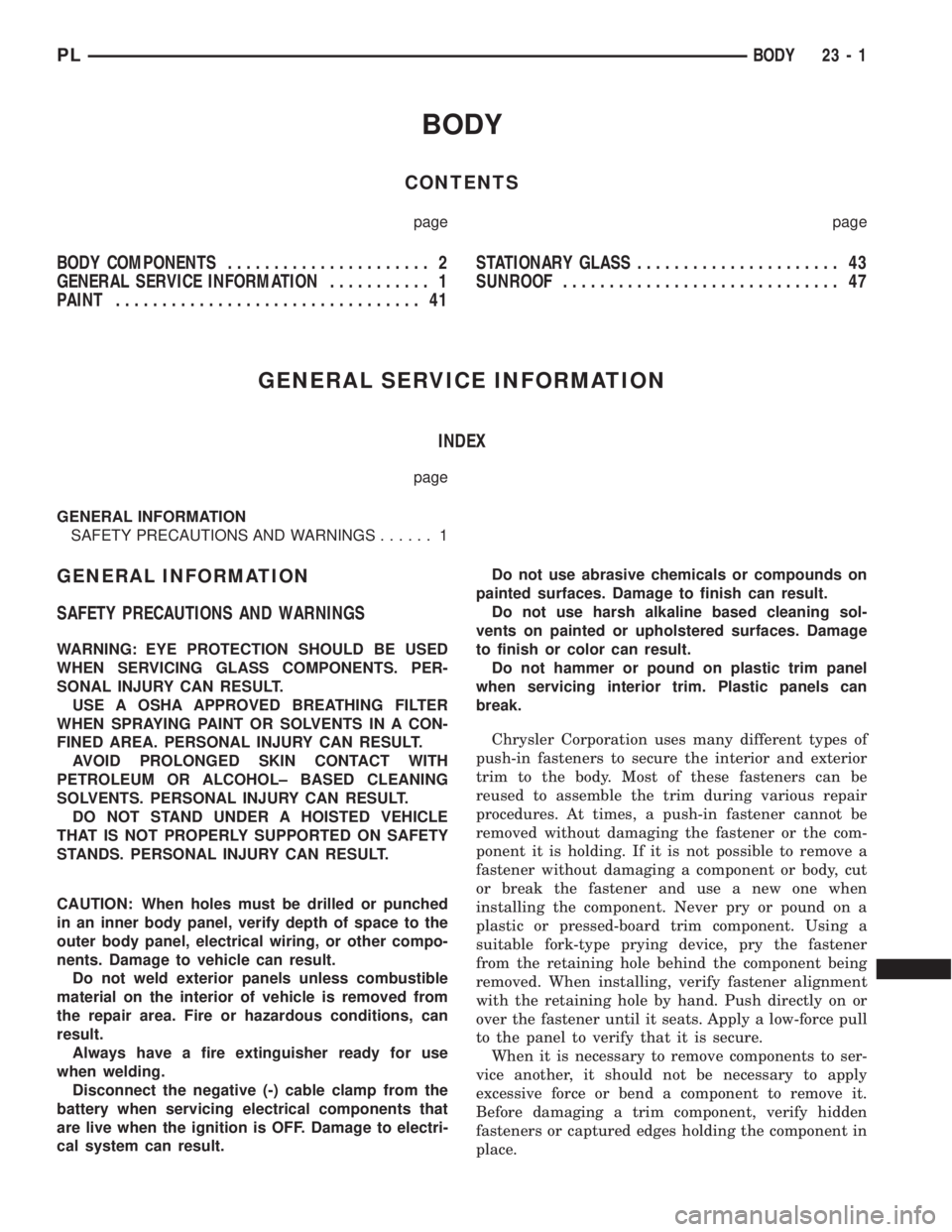
BODY
CONTENTS
page page
BODY COMPONENTS...................... 2
GENERAL SERVICE INFORMATION........... 1
PAINT................................. 41STATIONARY GLASS...................... 43
SUNROOF.............................. 47
GENERAL SERVICE INFORMATION
INDEX
page
GENERAL INFORMATION
SAFETY PRECAUTIONS AND WARNINGS...... 1
GENERAL INFORMATION
SAFETY PRECAUTIONS AND WARNINGS
WARNING: EYE PROTECTION SHOULD BE USED
WHEN SERVICING GLASS COMPONENTS. PER-
SONAL INJURY CAN RESULT.
USE A OSHA APPROVED BREATHING FILTER
WHEN SPRAYING PAINT OR SOLVENTS IN A CON-
FINED AREA. PERSONAL INJURY CAN RESULT.
AVOID PROLONGED SKIN CONTACT WITH
PETROLEUM OR ALCOHOL± BASED CLEANING
SOLVENTS. PERSONAL INJURY CAN RESULT.
DO NOT STAND UNDER A HOISTED VEHICLE
THAT IS NOT PROPERLY SUPPORTED ON SAFETY
STANDS. PERSONAL INJURY CAN RESULT.
CAUTION: When holes must be drilled or punched
in an inner body panel, verify depth of space to the
outer body panel, electrical wiring, or other compo-
nents. Damage to vehicle can result.
Do not weld exterior panels unless combustible
material on the interior of vehicle is removed from
the repair area. Fire or hazardous conditions, can
result.
Always have a fire extinguisher ready for use
when welding.
Disconnect the negative (-) cable clamp from the
battery when servicing electrical components that
are live when the ignition is OFF. Damage to electri-
cal system can result.Do not use abrasive chemicals or compounds on
painted surfaces. Damage to finish can result.
Do not use harsh alkaline based cleaning sol-
vents on painted or upholstered surfaces. Damage
to finish or color can result.
Do not hammer or pound on plastic trim panel
when servicing interior trim. Plastic panels can
break.
Chrysler Corporation uses many different types of
push-in fasteners to secure the interior and exterior
trim to the body. Most of these fasteners can be
reused to assemble the trim during various repair
procedures. At times, a push-in fastener cannot be
removed without damaging the fastener or the com-
ponent it is holding. If it is not possible to remove a
fastener without damaging a component or body, cut
or break the fastener and use a new one when
installing the component. Never pry or pound on a
plastic or pressed-board trim component. Using a
suitable fork-type prying device, pry the fastener
from the retaining hole behind the component being
removed. When installing, verify fastener alignment
with the retaining hole by hand. Push directly on or
over the fastener until it seats. Apply a low-force pull
to the panel to verify that it is secure.
When it is necessary to remove components to ser-
vice another, it should not be necessary to apply
excessive force or bend a component to remove it.
Before damaging a trim component, verify hidden
fasteners or captured edges holding the component in
place.
PLBODY 23 - 1
Page 1083 of 1200
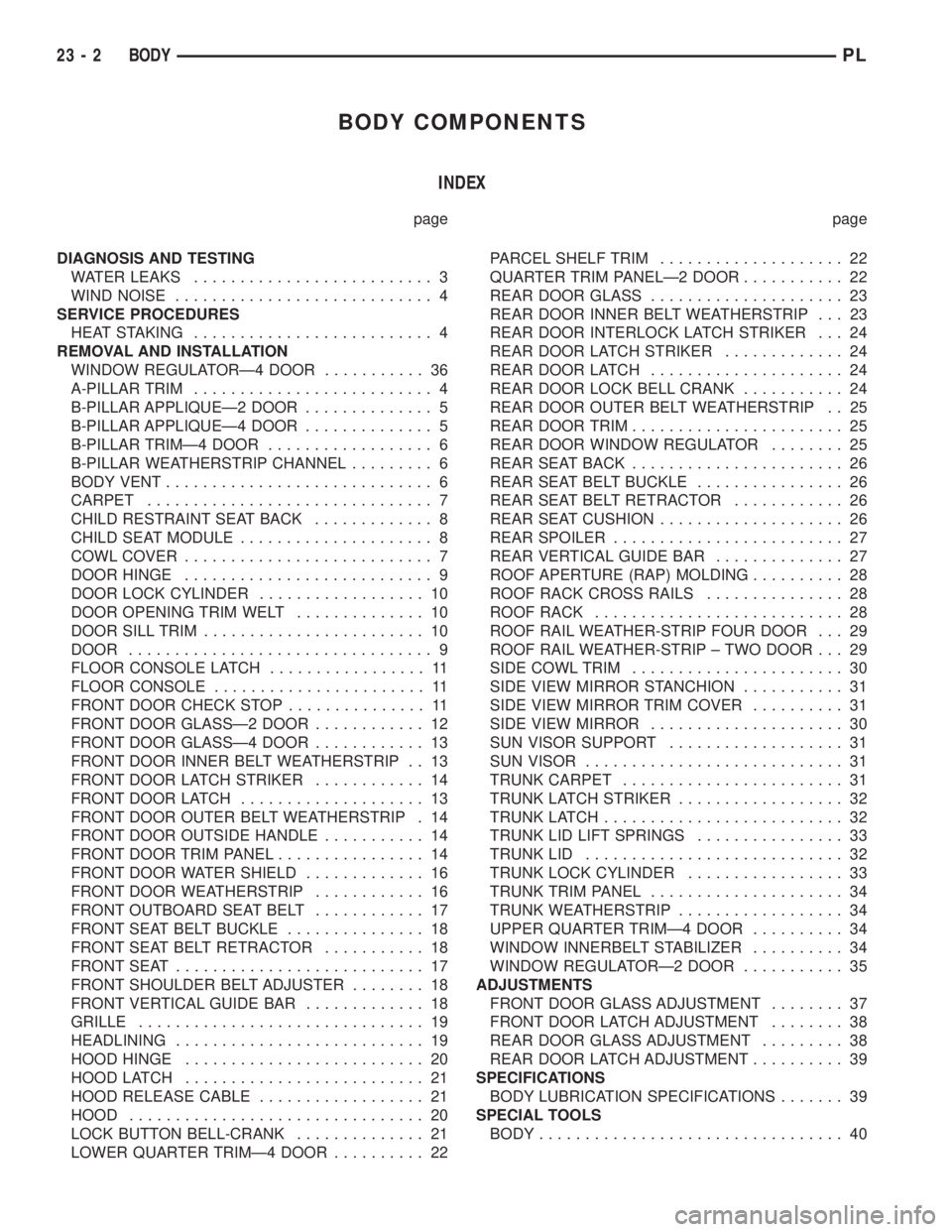
BODY COMPONENTS
INDEX
page page
DIAGNOSIS AND TESTING
WATER LEAKS.......................... 3
WIND NOISE............................ 4
SERVICE PROCEDURES
HEAT STAKING.......................... 4
REMOVAL AND INSTALLATION
WINDOW REGULATORÐ4 DOOR........... 36
A-PILLAR TRIM.......................... 4
B-PILLAR APPLIQUEÐ2 DOOR.............. 5
B-PILLAR APPLIQUEÐ4 DOOR.............. 5
B-PILLAR TRIMÐ4 DOOR.................. 6
B-PILLAR WEATHERSTRIP CHANNEL......... 6
BODY VENT............................. 6
CARPET............................... 7
CHILD RESTRAINT SEAT BACK............. 8
CHILD SEAT MODULE..................... 8
COWL COVER........................... 7
DOOR HINGE........................... 9
DOOR LOCK CYLINDER.................. 10
DOOR OPENING TRIM WELT.............. 10
DOOR SILL TRIM........................ 10
DOOR................................. 9
FLOOR CONSOLE LATCH................. 11
FLOOR CONSOLE....................... 11
FRONT DOOR CHECK STOP............... 11
FRONT DOOR GLASSÐ2 DOOR............ 12
FRONT DOOR GLASSÐ4 DOOR............ 13
FRONT DOOR INNER BELT WEATHERSTRIP . . 13
FRONT DOOR LATCH STRIKER............ 14
FRONT DOOR LATCH.................... 13
FRONT DOOR OUTER BELT WEATHERSTRIP . 14
FRONT DOOR OUTSIDE HANDLE........... 14
FRONT DOOR TRIM PANEL................ 14
FRONT DOOR WATER SHIELD............. 16
FRONT DOOR WEATHERSTRIP............ 16
FRONT OUTBOARD SEAT BELT............ 17
FRONT SEAT BELT BUCKLE............... 18
FRONT SEAT BELT RETRACTOR........... 18
FRONT SEAT........................... 17
FRONT SHOULDER BELT ADJUSTER........ 18
FRONT VERTICAL GUIDE BAR............. 18
GRILLE............................... 19
HEADLINING........................... 19
HOOD HINGE.......................... 20
HOOD LATCH.......................... 21
HOOD RELEASE CABLE.................. 21
HOOD................................ 20
LOCK BUTTON BELL-CRANK.............. 21
LOWER QUARTER TRIMÐ4 DOOR.......... 22PARCEL SHELF TRIM.................... 22
QUARTER TRIM PANELÐ2 DOOR........... 22
REAR DOOR GLASS..................... 23
REAR DOOR INNER BELT WEATHERSTRIP . . . 23
REAR DOOR INTERLOCK LATCH STRIKER . . . 24
REAR DOOR LATCH STRIKER............. 24
REAR DOOR LATCH..................... 24
REAR DOOR LOCK BELL CRANK........... 24
REAR DOOR OUTER BELT WEATHERSTRIP . . 25
REAR DOOR TRIM....................... 25
REAR DOOR WINDOW REGULATOR........ 25
REAR SEAT BACK....................... 26
REAR SEAT BELT BUCKLE................ 26
REAR SEAT BELT RETRACTOR............ 26
REAR SEAT CUSHION.................... 26
REAR SPOILER......................... 27
REAR VERTICAL GUIDE BAR.............. 27
ROOF APERTURE (RAP) MOLDING.......... 28
ROOF RACK CROSS RAILS............... 28
ROOF RACK........................... 28
ROOF RAIL WEATHER-STRIP FOUR DOOR . . . 29
ROOF RAIL WEATHER-STRIP ± TWO DOOR . . . 29
SIDE COWL TRIM....................... 30
SIDE VIEW MIRROR STANCHION........... 31
SIDE VIEW MIRROR TRIM COVER.......... 31
SIDE VIEW MIRROR..................... 30
SUN VISOR SUPPORT................... 31
SUN VISOR............................ 31
TRUNK CARPET........................ 31
TRUNK LATCH STRIKER.................. 32
TRUNK LATCH.......................... 32
TRUNK LID LIFT SPRINGS................ 33
TRUNK LID............................ 32
TRUNK LOCK CYLINDER................. 33
TRUNK TRIM PANEL..................... 34
TRUNK WEATHERSTRIP.................. 34
UPPER QUARTER TRIMÐ4 DOOR.......... 34
WINDOW INNERBELT STABILIZER.......... 34
WINDOW REGULATORÐ2 DOOR........... 35
ADJUSTMENTS
FRONT DOOR GLASS ADJUSTMENT........ 37
FRONT DOOR LATCH ADJUSTMENT........ 38
REAR DOOR GLASS ADJUSTMENT......... 38
REAR DOOR LATCH ADJUSTMENT.......... 39
SPECIFICATIONS
BODY LUBRICATION SPECIFICATIONS....... 39
SPECIAL TOOLS
BODY................................. 40
23 - 2 BODYPL
Page 1084 of 1200
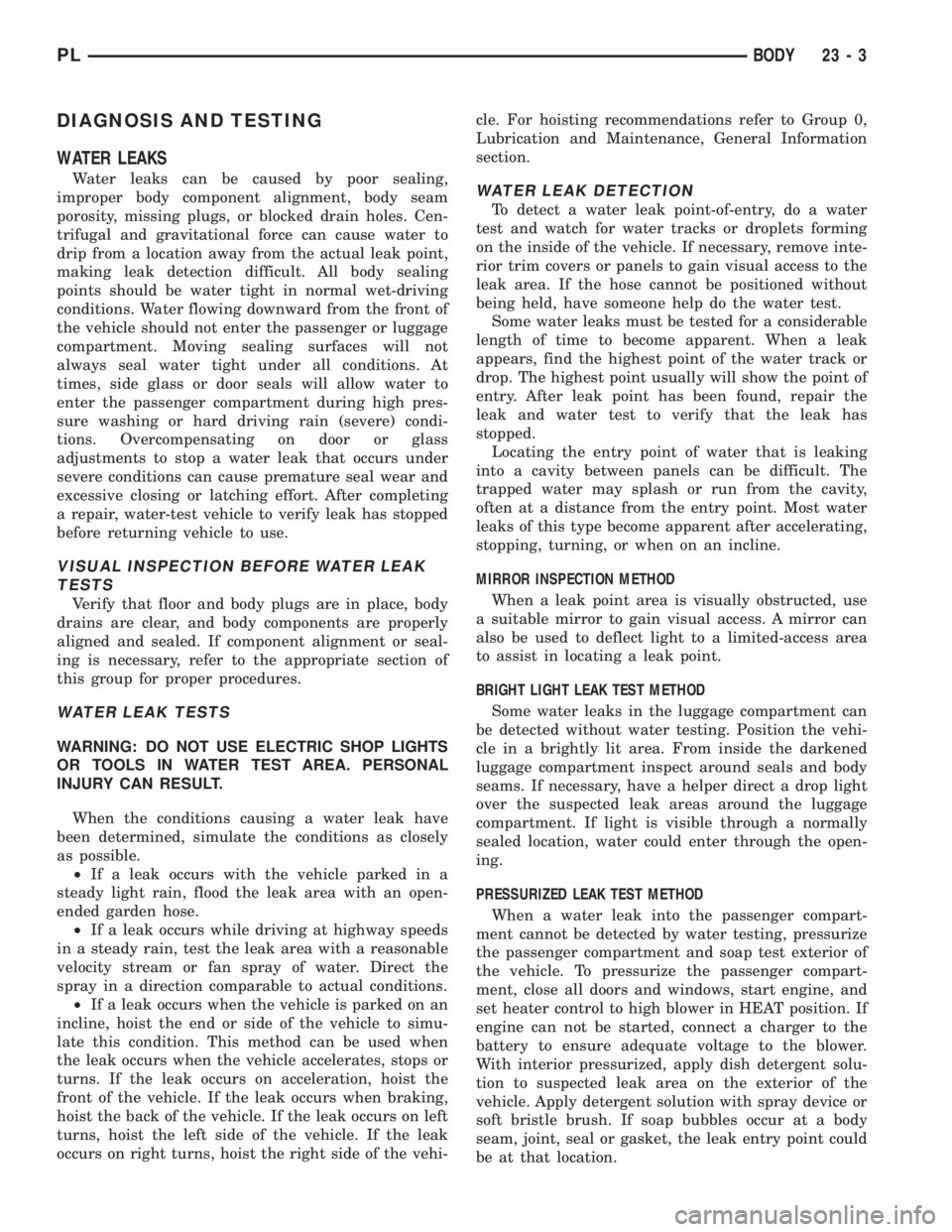
DIAGNOSIS AND TESTING
WATER LEAKS
Water leaks can be caused by poor sealing,
improper body component alignment, body seam
porosity, missing plugs, or blocked drain holes. Cen-
trifugal and gravitational force can cause water to
drip from a location away from the actual leak point,
making leak detection difficult. All body sealing
points should be water tight in normal wet-driving
conditions. Water flowing downward from the front of
the vehicle should not enter the passenger or luggage
compartment. Moving sealing surfaces will not
always seal water tight under all conditions. At
times, side glass or door seals will allow water to
enter the passenger compartment during high pres-
sure washing or hard driving rain (severe) condi-
tions. Overcompensating on door or glass
adjustments to stop a water leak that occurs under
severe conditions can cause premature seal wear and
excessive closing or latching effort. After completing
a repair, water-test vehicle to verify leak has stopped
before returning vehicle to use.
VISUAL INSPECTION BEFORE WATER LEAK
TESTS
Verify that floor and body plugs are in place, body
drains are clear, and body components are properly
aligned and sealed. If component alignment or seal-
ing is necessary, refer to the appropriate section of
this group for proper procedures.
WATER LEAK TESTS
WARNING: DO NOT USE ELECTRIC SHOP LIGHTS
OR TOOLS IN WATER TEST AREA. PERSONAL
INJURY CAN RESULT.
When the conditions causing a water leak have
been determined, simulate the conditions as closely
as possible.
²If a leak occurs with the vehicle parked in a
steady light rain, flood the leak area with an open-
ended garden hose.
²If a leak occurs while driving at highway speeds
in a steady rain, test the leak area with a reasonable
velocity stream or fan spray of water. Direct the
spray in a direction comparable to actual conditions.
²If a leak occurs when the vehicle is parked on an
incline, hoist the end or side of the vehicle to simu-
late this condition. This method can be used when
the leak occurs when the vehicle accelerates, stops or
turns. If the leak occurs on acceleration, hoist the
front of the vehicle. If the leak occurs when braking,
hoist the back of the vehicle. If the leak occurs on left
turns, hoist the left side of the vehicle. If the leak
occurs on right turns, hoist the right side of the vehi-cle. For hoisting recommendations refer to Group 0,
Lubrication and Maintenance, General Information
section.
WATER LEAK DETECTION
To detect a water leak point-of-entry, do a water
test and watch for water tracks or droplets forming
on the inside of the vehicle. If necessary, remove inte-
rior trim covers or panels to gain visual access to the
leak area. If the hose cannot be positioned without
being held, have someone help do the water test.
Some water leaks must be tested for a considerable
length of time to become apparent. When a leak
appears, find the highest point of the water track or
drop. The highest point usually will show the point of
entry. After leak point has been found, repair the
leak and water test to verify that the leak has
stopped.
Locating the entry point of water that is leaking
into a cavity between panels can be difficult. The
trapped water may splash or run from the cavity,
often at a distance from the entry point. Most water
leaks of this type become apparent after accelerating,
stopping, turning, or when on an incline.
MIRROR INSPECTION METHOD
When a leak point area is visually obstructed, use
a suitable mirror to gain visual access. A mirror can
also be used to deflect light to a limited-access area
to assist in locating a leak point.
BRIGHT LIGHT LEAK TEST METHOD
Some water leaks in the luggage compartment can
be detected without water testing. Position the vehi-
cle in a brightly lit area. From inside the darkened
luggage compartment inspect around seals and body
seams. If necessary, have a helper direct a drop light
over the suspected leak areas around the luggage
compartment. If light is visible through a normally
sealed location, water could enter through the open-
ing.
PRESSURIZED LEAK TEST METHOD
When a water leak into the passenger compart-
ment cannot be detected by water testing, pressurize
the passenger compartment and soap test exterior of
the vehicle. To pressurize the passenger compart-
ment, close all doors and windows, start engine, and
set heater control to high blower in HEAT position. If
engine can not be started, connect a charger to the
battery to ensure adequate voltage to the blower.
With interior pressurized, apply dish detergent solu-
tion to suspected leak area on the exterior of the
vehicle. Apply detergent solution with spray device or
soft bristle brush. If soap bubbles occur at a body
seam, joint, seal or gasket, the leak entry point could
be at that location.
PLBODY 23 - 3
Page 1085 of 1200
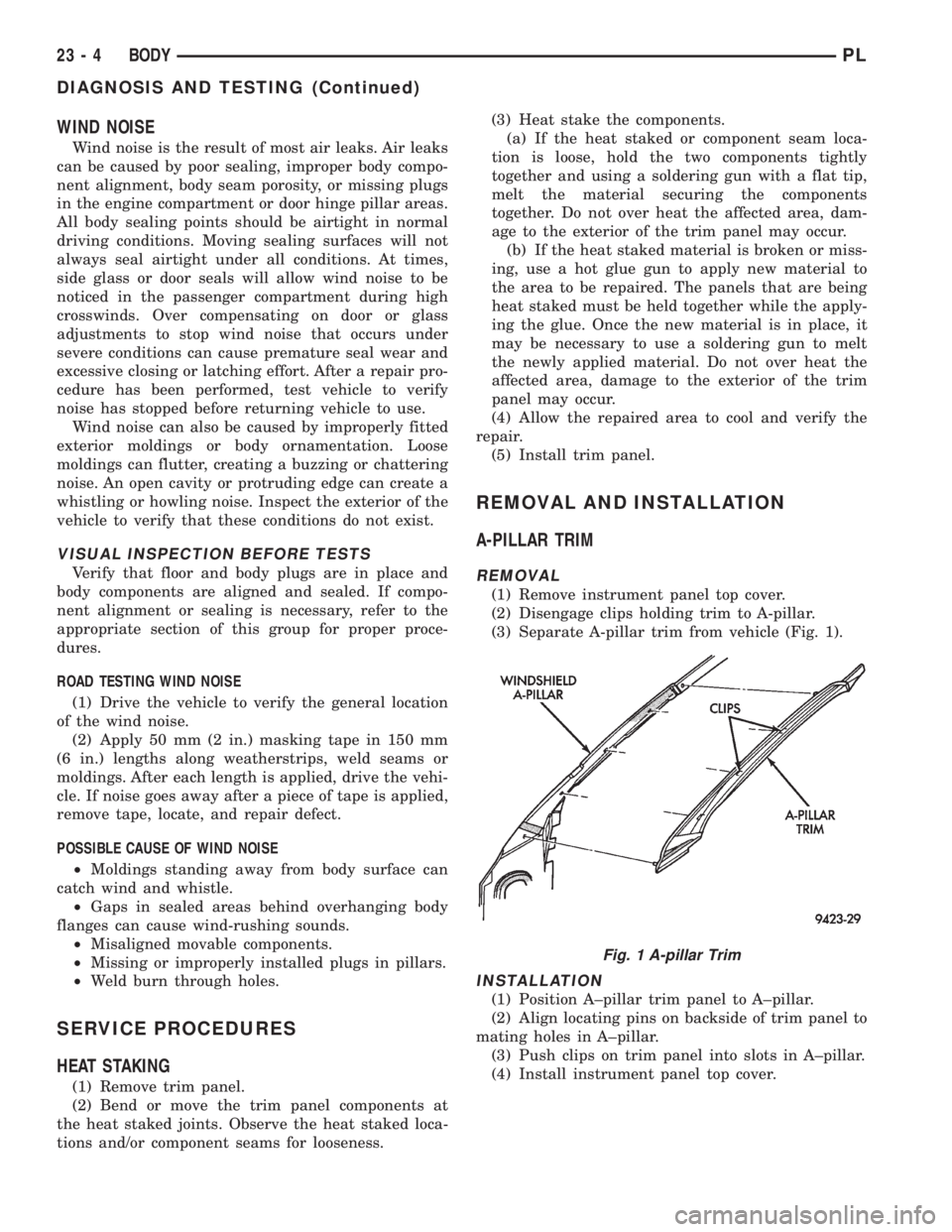
WIND NOISE
Wind noise is the result of most air leaks. Air leaks
can be caused by poor sealing, improper body compo-
nent alignment, body seam porosity, or missing plugs
in the engine compartment or door hinge pillar areas.
All body sealing points should be airtight in normal
driving conditions. Moving sealing surfaces will not
always seal airtight under all conditions. At times,
side glass or door seals will allow wind noise to be
noticed in the passenger compartment during high
crosswinds. Over compensating on door or glass
adjustments to stop wind noise that occurs under
severe conditions can cause premature seal wear and
excessive closing or latching effort. After a repair pro-
cedure has been performed, test vehicle to verify
noise has stopped before returning vehicle to use.
Wind noise can also be caused by improperly fitted
exterior moldings or body ornamentation. Loose
moldings can flutter, creating a buzzing or chattering
noise. An open cavity or protruding edge can create a
whistling or howling noise. Inspect the exterior of the
vehicle to verify that these conditions do not exist.
VISUAL INSPECTION BEFORE TESTS
Verify that floor and body plugs are in place and
body components are aligned and sealed. If compo-
nent alignment or sealing is necessary, refer to the
appropriate section of this group for proper proce-
dures.
ROAD TESTING WIND NOISE
(1) Drive the vehicle to verify the general location
of the wind noise.
(2) Apply 50 mm (2 in.) masking tape in 150 mm
(6 in.) lengths along weatherstrips, weld seams or
moldings. After each length is applied, drive the vehi-
cle. If noise goes away after a piece of tape is applied,
remove tape, locate, and repair defect.
POSSIBLE CAUSE OF WIND NOISE
²Moldings standing away from body surface can
catch wind and whistle.
²Gaps in sealed areas behind overhanging body
flanges can cause wind-rushing sounds.
²Misaligned movable components.
²Missing or improperly installed plugs in pillars.
²Weld burn through holes.
SERVICE PROCEDURES
HEAT STAKING
(1) Remove trim panel.
(2) Bend or move the trim panel components at
the heat staked joints. Observe the heat staked loca-
tions and/or component seams for looseness.(3) Heat stake the components.
(a) If the heat staked or component seam loca-
tion is loose, hold the two components tightly
together and using a soldering gun with a flat tip,
melt the material securing the components
together. Do not over heat the affected area, dam-
age to the exterior of the trim panel may occur.
(b) If the heat staked material is broken or miss-
ing, use a hot glue gun to apply new material to
the area to be repaired. The panels that are being
heat staked must be held together while the apply-
ing the glue. Once the new material is in place, it
may be necessary to use a soldering gun to melt
the newly applied material. Do not over heat the
affected area, damage to the exterior of the trim
panel may occur.
(4) Allow the repaired area to cool and verify the
repair.
(5) Install trim panel.
REMOVAL AND INSTALLATION
A-PILLAR TRIM
REMOVAL
(1) Remove instrument panel top cover.
(2) Disengage clips holding trim to A-pillar.
(3) Separate A-pillar trim from vehicle (Fig. 1).
INSTALLATION
(1) Position A±pillar trim panel to A±pillar.
(2) Align locating pins on backside of trim panel to
mating holes in A±pillar.
(3) Push clips on trim panel into slots in A±pillar.
(4) Install instrument panel top cover.
Fig. 1 A-pillar Trim
23 - 4 BODYPL
DIAGNOSIS AND TESTING (Continued)
Page 1086 of 1200
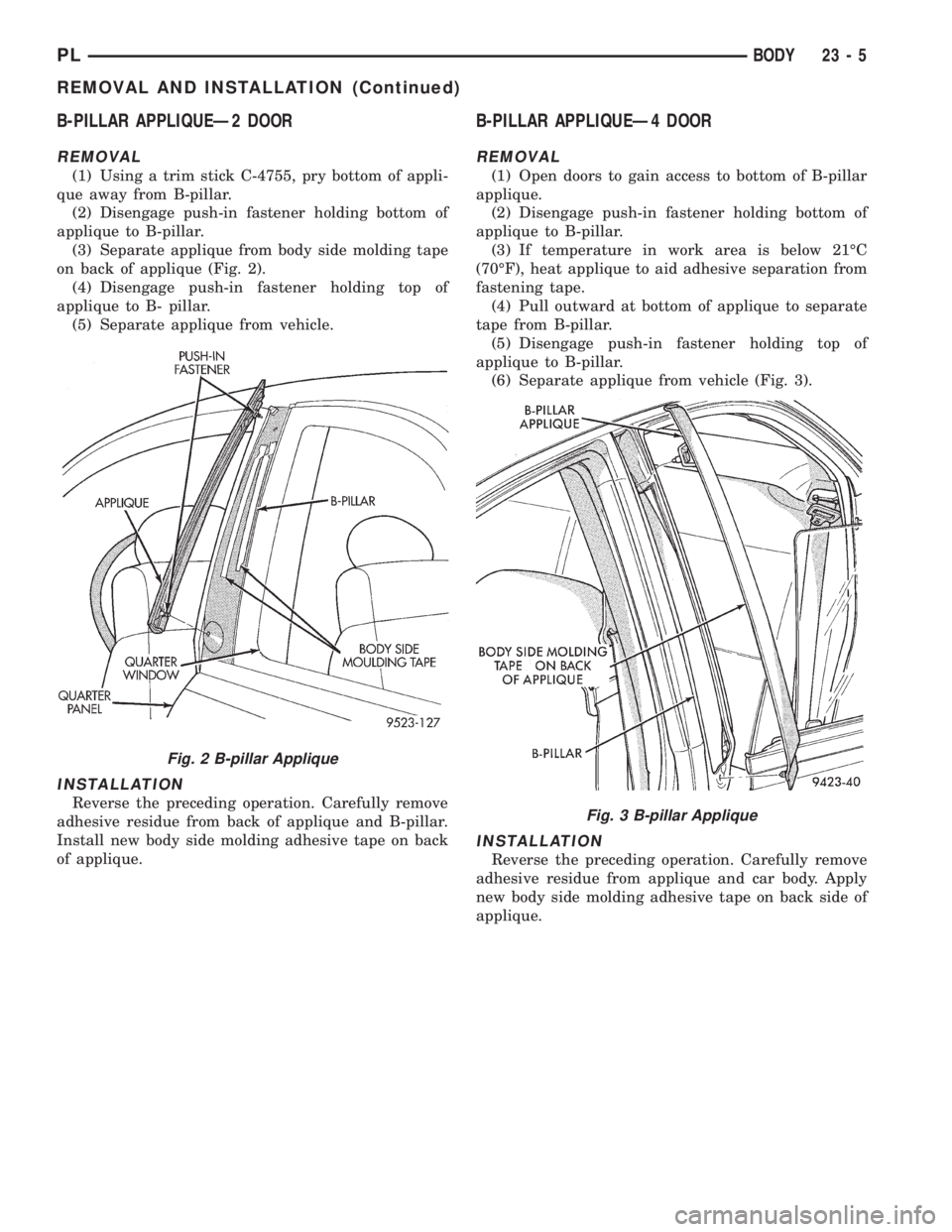
B-PILLAR APPLIQUEÐ2 DOOR
REMOVAL
(1) Using a trim stick C-4755, pry bottom of appli-
que away from B-pillar.
(2) Disengage push-in fastener holding bottom of
applique to B-pillar.
(3) Separate applique from body side molding tape
on back of applique (Fig. 2).
(4) Disengage push-in fastener holding top of
applique to B- pillar.
(5) Separate applique from vehicle.
INSTALLATION
Reverse the preceding operation. Carefully remove
adhesive residue from back of applique and B-pillar.
Install new body side molding adhesive tape on back
of applique.
B-PILLAR APPLIQUEÐ4 DOOR
REMOVAL
(1) Open doors to gain access to bottom of B-pillar
applique.
(2) Disengage push-in fastener holding bottom of
applique to B-pillar.
(3) If temperature in work area is below 21ÉC
(70ÉF), heat applique to aid adhesive separation from
fastening tape.
(4) Pull outward at bottom of applique to separate
tape from B-pillar.
(5) Disengage push-in fastener holding top of
applique to B-pillar.
(6) Separate applique from vehicle (Fig. 3).
INSTALLATION
Reverse the preceding operation. Carefully remove
adhesive residue from applique and car body. Apply
new body side molding adhesive tape on back side of
applique.
Fig. 2 B-pillar Applique
Fig. 3 B-pillar Applique
PLBODY 23 - 5
REMOVAL AND INSTALLATION (Continued)
Page 1087 of 1200
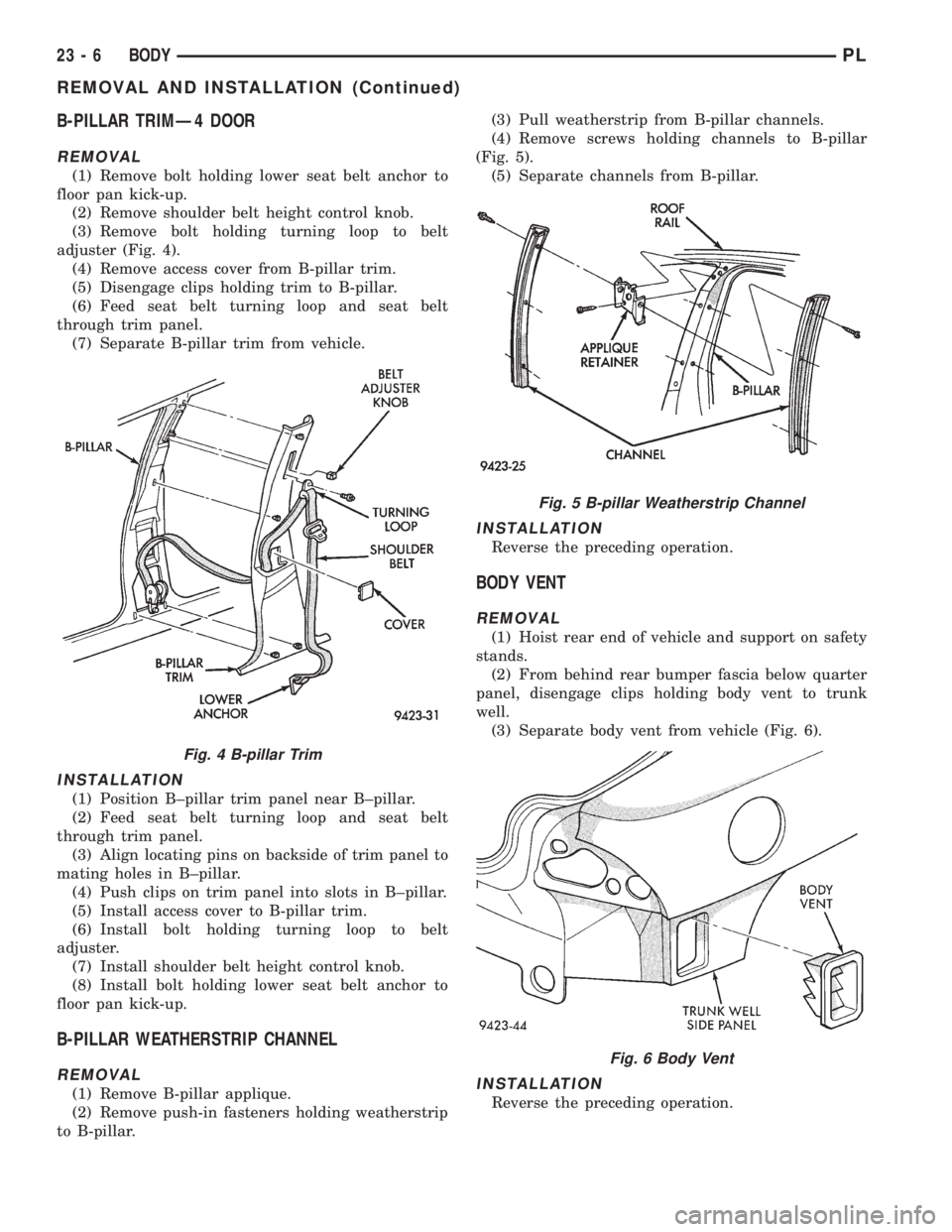
B-PILLAR TRIMÐ4 DOOR
REMOVAL
(1) Remove bolt holding lower seat belt anchor to
floor pan kick-up.
(2) Remove shoulder belt height control knob.
(3) Remove bolt holding turning loop to belt
adjuster (Fig. 4).
(4) Remove access cover from B-pillar trim.
(5) Disengage clips holding trim to B-pillar.
(6) Feed seat belt turning loop and seat belt
through trim panel.
(7) Separate B-pillar trim from vehicle.
INSTALLATION
(1) Position B±pillar trim panel near B±pillar.
(2) Feed seat belt turning loop and seat belt
through trim panel.
(3) Align locating pins on backside of trim panel to
mating holes in B±pillar.
(4) Push clips on trim panel into slots in B±pillar.
(5) Install access cover to B-pillar trim.
(6) Install bolt holding turning loop to belt
adjuster.
(7) Install shoulder belt height control knob.
(8) Install bolt holding lower seat belt anchor to
floor pan kick-up.
B-PILLAR WEATHERSTRIP CHANNEL
REMOVAL
(1) Remove B-pillar applique.
(2) Remove push-in fasteners holding weatherstrip
to B-pillar.(3) Pull weatherstrip from B-pillar channels.
(4) Remove screws holding channels to B-pillar
(Fig. 5).
(5) Separate channels from B-pillar.
INSTALLATION
Reverse the preceding operation.
BODY VENT
REMOVAL
(1) Hoist rear end of vehicle and support on safety
stands.
(2) From behind rear bumper fascia below quarter
panel, disengage clips holding body vent to trunk
well.
(3) Separate body vent from vehicle (Fig. 6).
INSTALLATION
Reverse the preceding operation.
Fig. 4 B-pillar Trim
Fig. 5 B-pillar Weatherstrip Channel
Fig. 6 Body Vent
23 - 6 BODYPL
REMOVAL AND INSTALLATION (Continued)
Page 1088 of 1200
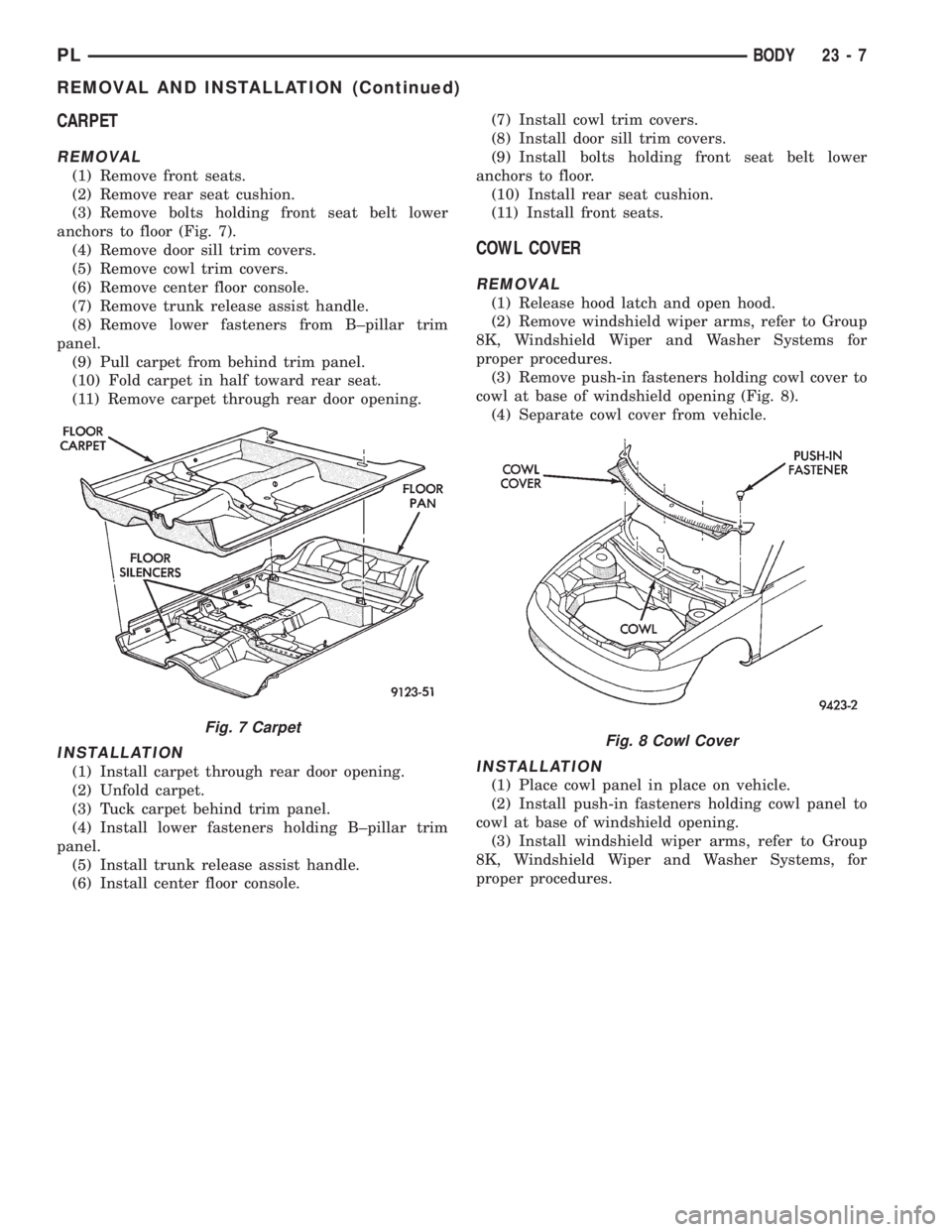
CARPET
REMOVAL
(1) Remove front seats.
(2) Remove rear seat cushion.
(3) Remove bolts holding front seat belt lower
anchors to floor (Fig. 7).
(4) Remove door sill trim covers.
(5) Remove cowl trim covers.
(6) Remove center floor console.
(7) Remove trunk release assist handle.
(8) Remove lower fasteners from B±pillar trim
panel.
(9) Pull carpet from behind trim panel.
(10) Fold carpet in half toward rear seat.
(11) Remove carpet through rear door opening.
INSTALLATION
(1) Install carpet through rear door opening.
(2) Unfold carpet.
(3) Tuck carpet behind trim panel.
(4) Install lower fasteners holding B±pillar trim
panel.
(5) Install trunk release assist handle.
(6) Install center floor console.(7) Install cowl trim covers.
(8) Install door sill trim covers.
(9) Install bolts holding front seat belt lower
anchors to floor.
(10) Install rear seat cushion.
(11) Install front seats.
COWL COVER
REMOVAL
(1) Release hood latch and open hood.
(2) Remove windshield wiper arms, refer to Group
8K, Windshield Wiper and Washer Systems for
proper procedures.
(3) Remove push-in fasteners holding cowl cover to
cowl at base of windshield opening (Fig. 8).
(4) Separate cowl cover from vehicle.
INSTALLATION
(1) Place cowl panel in place on vehicle.
(2) Install push-in fasteners holding cowl panel to
cowl at base of windshield opening.
(3) Install windshield wiper arms, refer to Group
8K, Windshield Wiper and Washer Systems, for
proper procedures.
Fig. 7 CarpetFig. 8 Cowl Cover
PLBODY 23 - 7
REMOVAL AND INSTALLATION (Continued)
Page 1089 of 1200
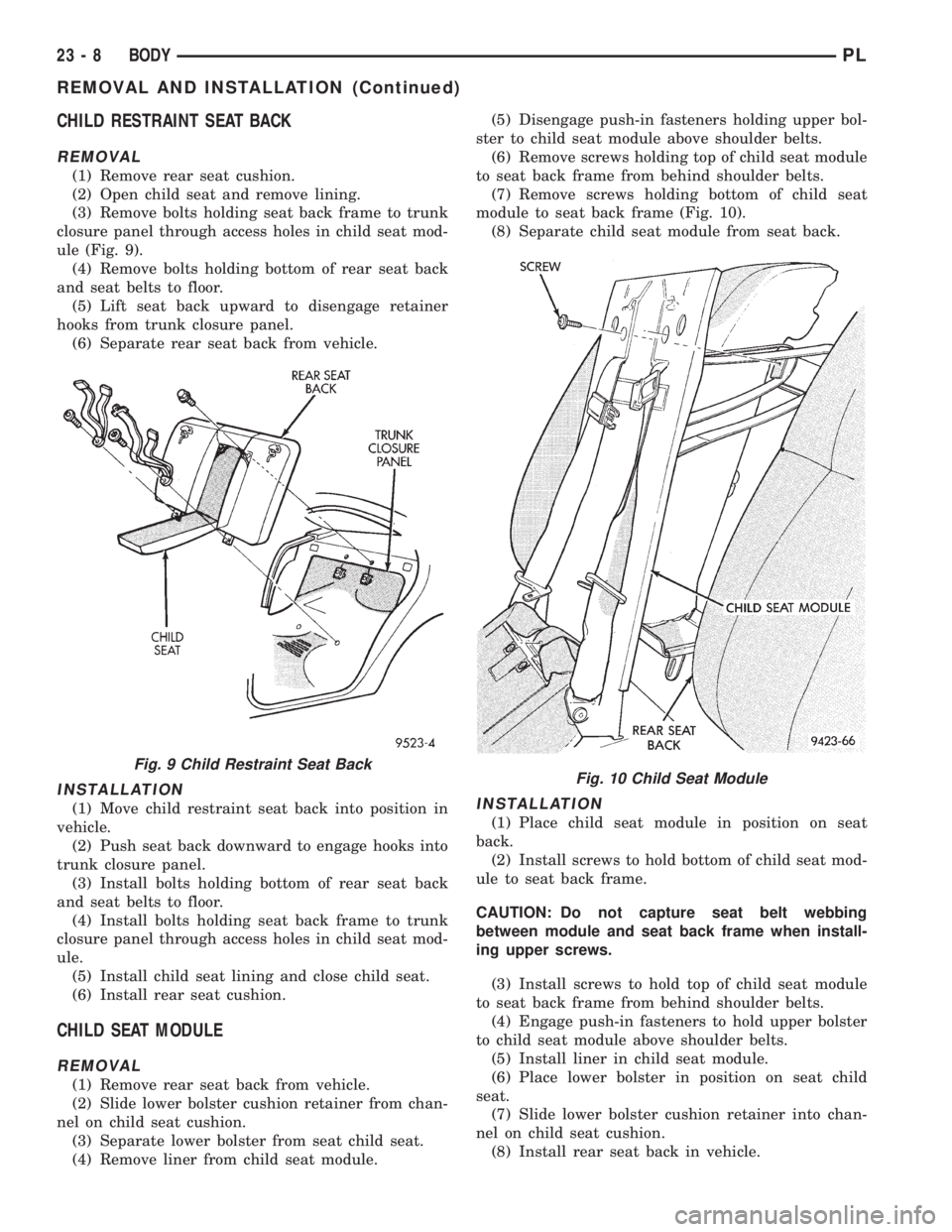
CHILD RESTRAINT SEAT BACK
REMOVAL
(1) Remove rear seat cushion.
(2) Open child seat and remove lining.
(3) Remove bolts holding seat back frame to trunk
closure panel through access holes in child seat mod-
ule (Fig. 9).
(4) Remove bolts holding bottom of rear seat back
and seat belts to floor.
(5) Lift seat back upward to disengage retainer
hooks from trunk closure panel.
(6) Separate rear seat back from vehicle.
INSTALLATION
(1) Move child restraint seat back into position in
vehicle.
(2) Push seat back downward to engage hooks into
trunk closure panel.
(3) Install bolts holding bottom of rear seat back
and seat belts to floor.
(4) Install bolts holding seat back frame to trunk
closure panel through access holes in child seat mod-
ule.
(5) Install child seat lining and close child seat.
(6) Install rear seat cushion.
CHILD SEAT MODULE
REMOVAL
(1) Remove rear seat back from vehicle.
(2) Slide lower bolster cushion retainer from chan-
nel on child seat cushion.
(3) Separate lower bolster from seat child seat.
(4) Remove liner from child seat module.(5) Disengage push-in fasteners holding upper bol-
ster to child seat module above shoulder belts.
(6) Remove screws holding top of child seat module
to seat back frame from behind shoulder belts.
(7) Remove screws holding bottom of child seat
module to seat back frame (Fig. 10).
(8) Separate child seat module from seat back.
INSTALLATION
(1) Place child seat module in position on seat
back.
(2) Install screws to hold bottom of child seat mod-
ule to seat back frame.
CAUTION: Do not capture seat belt webbing
between module and seat back frame when install-
ing upper screws.
(3) Install screws to hold top of child seat module
to seat back frame from behind shoulder belts.
(4) Engage push-in fasteners to hold upper bolster
to child seat module above shoulder belts.
(5) Install liner in child seat module.
(6) Place lower bolster in position on seat child
seat.
(7) Slide lower bolster cushion retainer into chan-
nel on child seat cushion.
(8) Install rear seat back in vehicle.
Fig. 9 Child Restraint Seat BackFig. 10 Child Seat Module
23 - 8 BODYPL
REMOVAL AND INSTALLATION (Continued)
Page 1090 of 1200
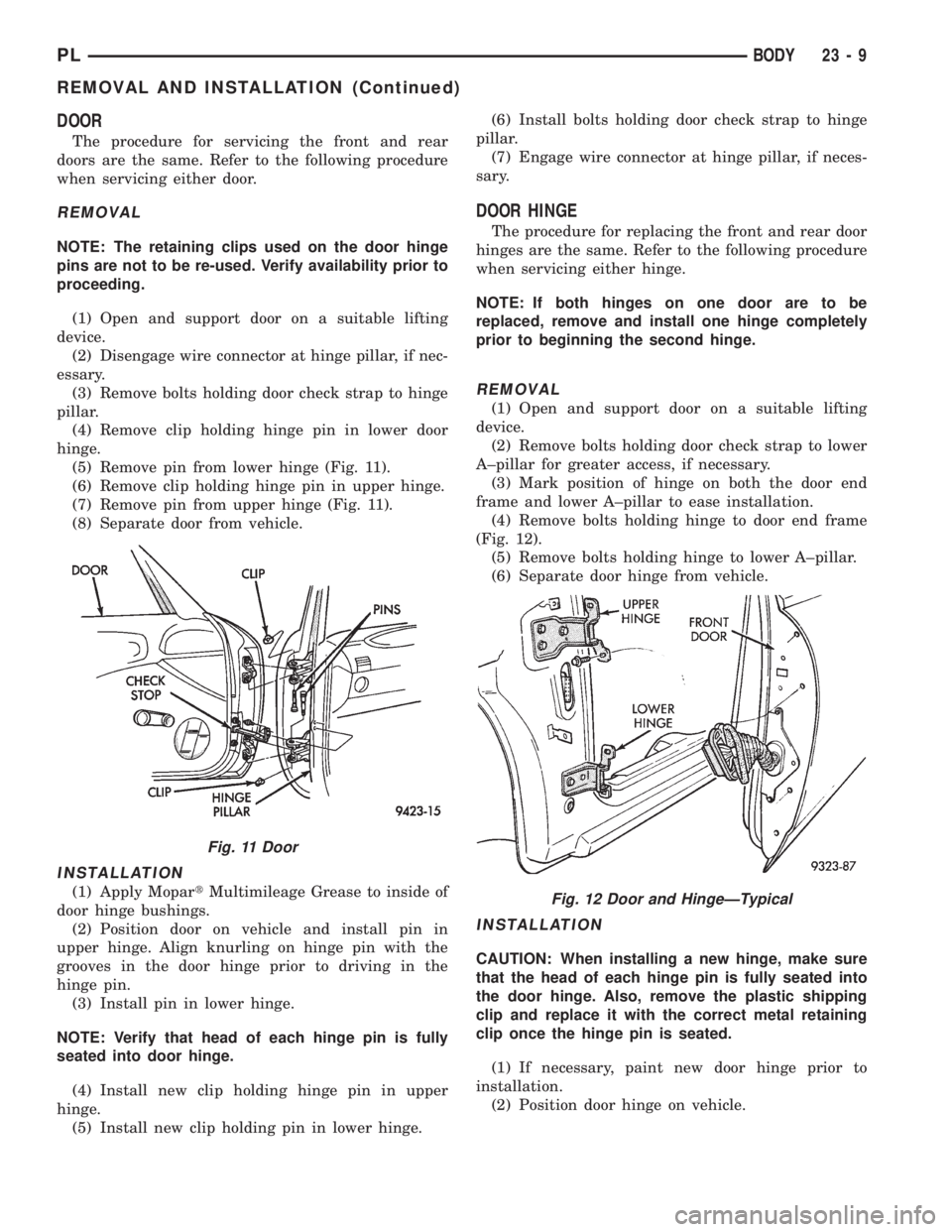
DOOR
The procedure for servicing the front and rear
doors are the same. Refer to the following procedure
when servicing either door.
REMOVAL
NOTE: The retaining clips used on the door hinge
pins are not to be re-used. Verify availability prior to
proceeding.
(1) Open and support door on a suitable lifting
device.
(2) Disengage wire connector at hinge pillar, if nec-
essary.
(3) Remove bolts holding door check strap to hinge
pillar.
(4) Remove clip holding hinge pin in lower door
hinge.
(5) Remove pin from lower hinge (Fig. 11).
(6) Remove clip holding hinge pin in upper hinge.
(7) Remove pin from upper hinge (Fig. 11).
(8) Separate door from vehicle.
INSTALLATION
(1) Apply MopartMultimileage Grease to inside of
door hinge bushings.
(2) Position door on vehicle and install pin in
upper hinge. Align knurling on hinge pin with the
grooves in the door hinge prior to driving in the
hinge pin.
(3) Install pin in lower hinge.
NOTE: Verify that head of each hinge pin is fully
seated into door hinge.
(4) Install new clip holding hinge pin in upper
hinge.
(5) Install new clip holding pin in lower hinge.(6) Install bolts holding door check strap to hinge
pillar.
(7) Engage wire connector at hinge pillar, if neces-
sary.
DOOR HINGE
The procedure for replacing the front and rear door
hinges are the same. Refer to the following procedure
when servicing either hinge.
NOTE: If both hinges on one door are to be
replaced, remove and install one hinge completely
prior to beginning the second hinge.
REMOVAL
(1) Open and support door on a suitable lifting
device.
(2) Remove bolts holding door check strap to lower
A±pillar for greater access, if necessary.
(3) Mark position of hinge on both the door end
frame and lower A±pillar to ease installation.
(4) Remove bolts holding hinge to door end frame
(Fig. 12).
(5) Remove bolts holding hinge to lower A±pillar.
(6) Separate door hinge from vehicle.
INSTALLATION
CAUTION: When installing a new hinge, make sure
that the head of each hinge pin is fully seated into
the door hinge. Also, remove the plastic shipping
clip and replace it with the correct metal retaining
clip once the hinge pin is seated.
(1) If necessary, paint new door hinge prior to
installation.
(2) Position door hinge on vehicle.
Fig. 11 Door
Fig. 12 Door and HingeÐTypical
PLBODY 23 - 9
REMOVAL AND INSTALLATION (Continued)